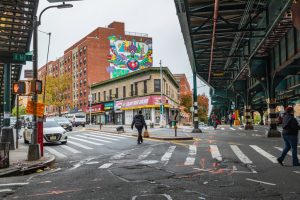Go to Page Section:
- Understanding Municipal Liability in New York City
- What Counts as a Dangerous Sidewalk Condition?
- The Importance of Prior Written Notice
- Filing a Notice of Claim: A Crucial Deadline
- What You Need to Prove in a Lawsuit
- Real Cases and Data: The City’s Liability Exposure
- Why Legal Representation Matters
- Final Thoughts
When a slip and fall accident happens on a public sidewalk in the Bronx, one of the first questions a person might ask is:
Can I sue the City of New York?

In many cases, the answer is yes, but with important limitations.
New York has specific sidewalk liability rules, which can be complicated when the city or another municipal entity is involved.
Understanding how these laws work is essential if you’ve been injured due to a dangerous sidewalk in the Bronx.
Understanding Municipal Liability in New York City
Slip and fall accidents on sidewalks are among the most common personal injury claims in New York City.
The NYC Department of Health reported that falls are the leading cause of injury-related hospitalizations among older adults in the city, with thousands of cases each year stemming from sidewalk hazards such as uneven pavement, cracks, or unremoved snow and ice.
But not every fall automatically makes the city liable.
In most instances, property owners are responsible for maintaining the sidewalk adjacent to their buildings.
This responsibility was solidified by New York City Administrative Code Section 7-210, which shifted liability for sidewalk maintenance from the city to most adjacent property owners in 2003.
According to this law, property owners—including commercial property owners and owners of multi-family buildings—must keep the sidewalks in front of their buildings in reasonably safe condition.
However, there are exceptions. The City of New York may still be responsible for sidewalk maintenance in certain scenarios.
For example, if the sidewalk is adjacent to a one-, two-, or three-family residential property that is owner-occupied and used exclusively for residential purposes, then liability may revert to the city.
The same applies if the dangerous condition exists in a location where no private property owner has a maintenance obligation, such as public parks, city-owned lots, or sidewalks in front of certain public buildings.
What Counts as a Dangerous Sidewalk Condition?
To successfully sue the City of New York for a Bronx sidewalk fall, a key requirement is proving that the sidewalk was in a dangerous or defective condition.
Common defects include:
- Cracked or broken concrete
- Uneven slabs create tripping hazards
- Potholes or depressions that accumulate water or ice
- Raised metal covers or utility grates
- Improperly shoveled snow or ice during the winter months
It’s not enough to simply fall.
The condition must be legally considered dangerous, and the city must have had notice of the defect before the accident occurred.
The Importance of Prior Written Notice
Under New York law, a municipality cannot be held liable for a sidewalk defect unless it received “prior written notice” of the condition at least 15 days before the accident.
This requirement is established by New York City Administrative Code Section 7-201(c)(2).
The notice must have come in the form of a written complaint filed with the proper city agency, such as the Department of Transportation (DOT).
One way that prior written notice can be proven is through what’s known as a “Big Apple Map.”
These maps were created by the Big Apple Pothole and Sidewalk Protection Corporation, a nonprofit organization that submitted maps with marked defects to the DOT.
Courts have ruled in many cases that these maps can satisfy the prior written notice requirement.
If the city didn’t receive prior written notice, a lawsuit against the city would generally be dismissed, even if the sidewalk was hazardous.
However, there are rare exceptions—for example, if the city affirmatively created the dangerous condition through a construction project or repair and did so negligently.
Filing a Notice of Claim: A Crucial Deadline
Before you can sue the City of New York, you must file a legal document called a Notice of Claim.
This is different from filing a lawsuit.
A Notice of Claim is a formal notification that you intend to pursue legal action and allows the city to investigate the matter.
A Bronx-based slip and fall attorney can help you with all the paperwork and guide you through the process, so that should be your next step: hiring an experienced professional.
In New York, you must file the Notice of Claim within 90 days of the accident.
This deadline is strict.
Missing it can result in losing your right to sue the city, even if your injuries are severe and the city is clearly at fault.
Once the Notice of Claim is filed, the city has 30 days to request a hearing known as a 50-h hearing, which is similar to a deposition.
After that, you may file a lawsuit, but it must be done within one year and 90 days of the accident.
These time limits are shorter than those for most personal injury claims against private entities, typically allowing up to three years to file suit.
What You Need to Prove in a Lawsuit
Successfully suing the City of New York for a Bronx sidewalk fall requires more than just proving you were injured.
Your legal team must establish several elements:
- The sidewalk was defective and unsafe.
- The city-owned or was responsible for maintaining the sidewalk.
- The city had prior written notice (or created the defect).
- The defect directly caused your injuries.
- You suffered damages—physical, emotional, or financial.
Supporting evidence can include photographs of the defect, medical records, witness testimony, surveillance footage, and documented complaints or city inspection reports.
In many cases, expert testimony from an engineer or sidewalk safety specialist is also used to confirm that the defect was dangerous and preventable.
Real Cases and Data: The City’s Liability Exposure
Lawsuits against the city are not uncommon. According to New York City’s Office of the Comptroller, the city paid over $1.1 billion in personal injury settlements and judgments in fiscal year 2022 alone.
While not all of this stemmed from sidewalk injuries, trip, and fall incidents account for a significant portion of claims against the city.
A 2019 report from the Independent Budget Office of New York City revealed that over five years, the city paid out an average of $66 million annually for sidewalk injury claims.
These numbers highlight both the prevalence of sidewalk-related accidents and the importance of proper legal representation when pursuing a claim.
Why Legal Representation Matters
Lawsuits involving municipal defendants are more complex than typical injury cases.
From the notice requirements to the shortened statute of limitations and the technicalities of proving prior written notice, pursuing a slip and fall claim against the City of New York is not something most people should attempt without legal help.
A slip-and-fall attorney who understands local infrastructure, court procedures, and municipal liability can greatly improve your chances of a successful outcome.
They can quickly investigate the scene, identify the correct liable party, file the necessary documents within the required deadlines, and negotiate aggressively with city attorneys or insurance representatives.
Final Thoughts
If you’ve suffered a sidewalk fall in the Bronx, don’t assume that you have no legal options.
In certain situations, you absolutely can sue the City of New York—but doing so requires quick action, legal strategy, and a deep understanding of municipal liability laws.
By working with a knowledgeable slip and fall attorney, you can hold the right party accountable and pursue fair compensation for your injuries.


Leave a Reply